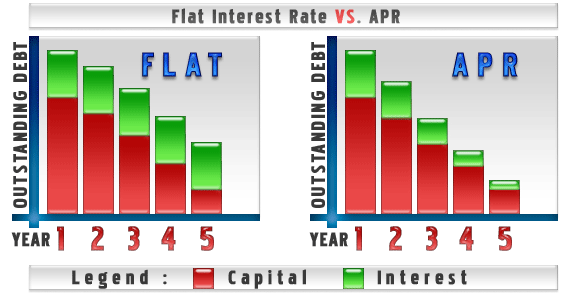Interest rates indicate the price at which you can borrow money. It can get seriously complicated, with many anomalies, so for starters I'm going to simply explain the basics, then step it up a notch. If it gets too much, just stop – understanding the basics alone is the most important bit!
Also in this guide
The interest rate you pay to borrow
If you borrow money at a 5% interest rate for a year, it will cost you 5% of the amount borrowed to do so; this will need to be repaid along with the original money you borrowed. Interest rates are usually quoted annually, but not always, so do check.
An Example to clarify
How much does it cost to borrow £1,000 at 10% then repay it six months later?
Let's start with a simple sum, one year at 10% would cost you £100 (ten percent of £1,000). Therefore over six months you'd pay about a half of that, in other words £50. It really is almost as simple as that.
The reason I say ‘almost' is that it isn't exactly half of that, due to compound interest (see below). However, this is a good rough rule-of-thumb way to think about it.
The interest rate when saving/in-credit
This works in exactly the same way, and there's a simple reason why. When you are in-credit or saving with a bank, you are effectively lending it your money to do with as it pleases until you want it back.
Therefore the savings rate is what the bank pays you for borrowing your money.
An example with savings
How much will you make by saving £1k at 5% for nine months?
Another simple sum to start, if you saved this for a year you'd earn £50 (five percent of £1,000), but as you've only got the money there for nine months you'd actually get around three quarters of this, which is £37.50. Again this isn't exact due to compound interest.
See the Top Savings guide for more information.
The thorny issue of tax and interest
Thankfully there's no tax on borrowing money, you simply pay back what you owe and the government doesn't get its hands on it.
Yet when you earn money from savings the interest earned counts as ‘income', so you have to pay income tax on it. The amount you pay depends on how much you earn in total – adding up employment and savings income.
- 10% rate tax. The ten percent band was scrapped on salary income in 2008, but not for savings. If you earn between £7,475 and £10,035 in 2011/12 you'll pay 10% of any savings income to the taxman.
- Basic rate tax. Most people who pay the basic rate of tax (roughly those who earn between £10,035 and £42,475 in 2011/12) pay 20% of their savings income in tax, the same level as on employment income
- Higher rate tax. Those who pay the higher rate of tax (roughly those who earn between £42,475 and £150,000 in 2011/12) pay 40% on both.
- 'Additional' rate tax. In the 2010/11 tax year, a new 50% rate of tax was introduced for anyone who earns over £150,000 - if your salary tops this then half your saving interest will disappear in tax.
-
Non taxpayers. Those who don't pay any income tax (roughly those whose income is under £7,475 in 2011/12) don't pay any tax on savings. This usually includes students and children, who are taxed like anyone else, but rarely earn over the threshold.
If you're a non-taxpayer your savings will still automatically have the basic rate of tax taken off them – this can be reclaimed at the end of the year. Alternatively fill in a R85 form when it's opened and they will be paid gross (which means before tax).
For more information on personal allowances and rates, read the Tax Rates guide.
One quick tip - married partners can give each other money without any tax impact. Therefore, if one of you is on a lower tax band, putting the savings in their name should mean you pay less tax on the interest earned. Although only ever do this if you're in a trusting relationship
How compound interest works
This is a really important issue, it's a core building block of everything to do with saving and borrowing. So hopefully we can explain it clearly.
Suppose you had £1,000 in a savings account which paid 10% annual interest after tax (if only!). After year one you'd have £1,000 plus £100 interest (10% of £1,000), a total of £1,100. Yet after year two, you'd earn another £100 interest (the interest on the original £1,000), plus a further £10 of interest earned on the £100 interest from the first year. So now you've a total of £210.
By year three, you'd be earning interest on the interest from year two, and interest on the interest on the interest from year one (gulp). And that's basically what compounding is all about.
Hopefully a graph will make this all clear:
All this means that the money grows more quickly because you don't just earn interest on the money you originally save, you also earn interest on the interest. This makes a big difference...
The longer you save for, the greater the effect of compound interest.
Let's say you put that money away for 20 years. If you were only earning the £100 a year, without the compounding, you'd have £3,000 in the bank afterwards. However because of the interest on the interest you actually have £6,700.
Remember this accelerates debts too!
Borrow money and as well as paying interest on the original borrowing, you pay interest on the interest accrued. Therefore...
The longer you borrow for, the quicker your debts grow.
Sadly compound interest tends to have an even bigger impact on debts than on savings, because interest rates are higher. Eg, borrow £1,000 at 15% over twenty years without making any repayments and you'd owe a massive £16,400 (without compound interest it'd be £4,000).
Rough compound interest calculation rule of thumb for maths nerds
Divide 72 by the annual interest rate and that's approximately how long it takes debts to double, eg, 72 divided by 9% equals 8 years. This starts to get less accurate for rates over 20%.
APRs - The official rate for borrowing
Right, now we're going to get a little bit technical. APR stands for the Annual Percentage Rate, and when it's calculated it has to include both the cost of the borrowing and any associated fees that are automatically included. Thus it's meant to give you the overall equivalent cost of a debt. This is from the regulator, the Financial Services Authority (FSA).
APR stands for the Annual Percentage Rate of charge. You can use it to compare different credit and loan offers. The APR takes into account not just the interest on the loan but also other charges you have to pay, for example, any arrangement fee. All lenders have to tell you what their APR is before you sign an agreement. It will vary from lender to lender.”
The fact it includes charges means sometimes the APR can be a bit confusing. It is possible the interest rate is 14% per annum, but due to charges the APR is 17%, as the impact of the charges adds the equivalent to another 3% interest. Yet this is useful as it allows a true comparison.
Beware banks quoting monthly interest
Often if a credit card company ups the interest it charges, the letter informing you will express this in monthly terms. This makes it sound significantly smaller, yet 2% monthly interest is a whopping 27% APR. Due to compounding, it's not as simple as multiplying by 12 to work this out though, so to help we've built a special calculator to show you the real rate.
The Interest Rate Converter
Plug in the interest rate on your statement and choose whether you want to convert from 'Monthly to Yearly" or vice versa. Click calculate and the converter will switch your interest rate into the one you requested.
Problems with the APR rate
While it all sounds good so far, unfortunately there are a number of problems with APR. Here are three of the main things to watch for.
-
It doesn't make sense with changing rates
The APR is meant to indicate the amount you will pay each year over the full term of the debt. Yet when rates change this can make it more rather than less complicated.
Mortgages are the best example. The APR is calculated by taking the total interest cost over the 25 year term of the mortgage, plus fees and this figure must be included prominently in mortgage adverts and brochures.
Yet what does it mean practically? A mortgage could tout 6.6% APR, yet you may never be charged 6.6%; instead you get a 4.5% fixed rate for two years followed by 6.75% variable for the remainder of the term. The 6.6% is the averaged cost if you were in the unlikely situation of keeping that mortgage for the full 25 year term, not a very useful figure (for more details read the Guide to Remortgaging). - You won't necessarily get the advertised APR
So far we've explained what APR means, however where the term 'representative APR' is used, this means that 51% of successful applicants will be given the advertised interest rate, the rest will most likely get a higher rate...
Credit Cards
With credit cards, the rate for purchases (as opposed to balance transfers or cash withdrawals) is used as the main rate to advertise the card.
So if that is described as 19.9% representative APR, then 51% of people accepted will get 19.9% APR, but 49% will get a different rate (likely to be higher).
Personal Loans
Loans are slightly simpler as they only have one rate. So if a loan is advertised as being 7.5% representative APR, this means 51% of accepted applicants will get 7.5%, and 49% will get a different rate (likely to be higher).
Of course, some people will be rejected outright for the card or loan too.
-
It only includes compulsory charges
Get a loan and some lenders will automatically include payment protection insurance in the quote. Technically this is voluntary, but you usually need to opt out (and you should do – read the Cheap Loans article). Yet while we're pushed to get the insurance, as it isn't compulsory, its cost isn't included in the APR.
Therefore some lenders deliberately load the cost of the insurance policies and make the loan rate cheaper. This means that with payment protection insurance a 6.7% APR loan can and cost more than a 8% APR loan, as the latter has much cheaper insurance.
AERs - The official rate for savings
The AER or Annual Equivalent Rate is the official rate for savings accounts, and is designed to allow easy comparisons as it's meant to smooth out the variances between accounts (it's the equivalent of the APR for debts).
The idea is it shows what you'd get over a year if you put money in the account and left it there. The alternative is the Gross rate, which is the flat rate of interest that's actually paid.
Frankly this next bit is about to get seriously complicated, so unless you're finding it all crystal clear so far, I'd skip it. If you don't read on, just remember the real lesson is ‘always compare like with like, thus AER with AER or Gross with Gross.'
Both these rates are usually quoted before tax, but there are two main areas where the difference shows:
- Monthly or Yearly Interest.
If interest is paid annually then the Gross rate and AER should be the same, as there's no ‘interest compounding'.
Yet when interest is paid monthly, then the Gross rate given is usually around 0.1% less than the AER rate. This is because if the monthly interest were left in the account, then there would be interest on the interest too. The AER makes sure that this is included.
Eg, for an identical account, if interest is paid monthly it would be a 4.89% Gross rate, but if interest were paid annually it would be 5% Gross. Leave the money there over a year, though, and both would receive the same amount, as the AER for both is 5%. - Bonus Rates of Interest.
The second confusion is the impact of bonus interest rates. If a bonus is being paid for six months, then the AER (which stands for Annual Equivalent Rate remember), would be less than the Gross rate for the first six months as it would need to incorporate the period pre- and post-bonus.
However, if you're planning to shift accounts when the bonus rate ends, then the AER is irrelevant, as you only want to know the interest rate during the bonus period. So, in this case, you should switch rates and compare Gross (and take note of whether it's monthly or yearly interest!)
See the Top Savings guide for more information.
Watch out for flat interest rate loans
Well, we slagged off APRs earlier, but there's a much worse measure out there. It's commonly used in the car loan market, but can occasionally be used for personal loans or in-store sales loans.
If the three little letters A, P and R don't follow the rate of a personal or car loan… danger! APRs automatically mean the rate is charged on any outstanding debt. Borrow £5,000 over 5 years and by the last year you only pay interest on the amount remaining, say £1,000. At 6% APR the total interest is £800.
With a flat rate the interest is charged on the original amount borrowed, no matter what's been repaid, so in the last year you still pay interest on the whole £5,000. With a 6% flat rate, the total interest is £1,500.
Hence 6% sounds cheap but is roughly equivalent to a costly 12% APR, so if in doubt ask "what's the total I'll repay including all charges?”
See the Cheap Loans guide for more information.












